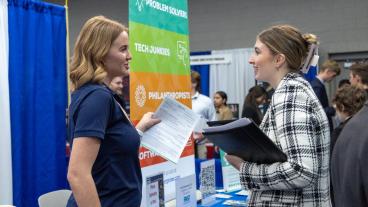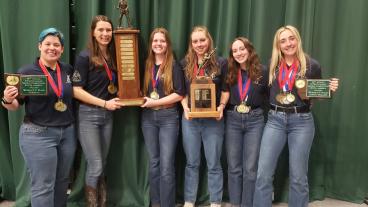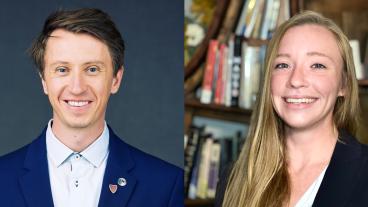A deep space gateway near the moon could one day serve as a staging point for spacecraft carrying humans to Mars and beyond.
NASA proposed the concept last year and two student teams with ties to Colorado School of Mines are now working to develop the best conceptual mission to help NASA take advantage of that future gateway and deep space transport systems.
Project POSEIDON (Polar Sample Extraction In-situ Drilling Operations Network) and PORG Station (Planetary Orbiter: a Rotational Gravity Station) are among the 16 collegiate teams that made the finals of the 2018 Revolutionary Aerospace Systems Concepts – Academic Linkage (RASC-AL) competition, set for June 18-21 in Cocoa Beach, Florida.
Undergraduate and graduate student teams could choose from four project categories – reusable hybrid propulsion stage, artificial gravity, propellant resupply capability and lunar polar sample return architecture. The top two winning teams overall will receive a travel stipend to present their concepts at an upcoming aerospace conference, such as American Institute of Aeronautics and Astronautics (AIAA) Space 2018.
“We’re solving real problems that the space industry faces. This is the next step for space resources and it’s cool to have a part in designing the future of what’s going to be such a huge component of humankind’s future in space,” said Adam Marcinkowski, a junior studying mechanical engineering and team leader of Project POSEIDON.
POSEIDON tackled the lunar polar sample return architecture challenge, proposing a reusable system of lunar rovers equipped with drills to take samples from the regolith, or moon dust, and then return them to the deep space gateway for analysis back on Earth.
The rovers would target the permanently shadowed regions of the moon, where scientists believe there could be as much as 1 billion metric tons of water ice. More specifically, the team chose the Cabeus crater, where a past mission crashed a rocket stage and detected water and hydrates in the resulting plume.
“Moon mining follows the same process as mining on Earth. With any terrestrial mining operation, at first, you're going to need to prospect it. We've already done that using satellites on the moon with promising results. The next step is to send someone in to get physical samples. What's the actual concentration on this site? Is it high enough for this mine to be worth the cost? It’s hard to know how much of the ore you want is present without taking a physical sample. That’s our next step on the moon,” Marcinkowski said.
Marcinkowski and his teammates entered the RASC-AL competition as an extracurricular activity, working on the project outside of their classes. Team members come from a variety of disciplines, including mechanical engineering, electrical engineering, engineering physics, petroleum engineering, mining engineering and geophysics.
Advising the team is Jamal Rostami, associate professor and Timothy J. Haddon/Alacer Gold Chair in Mining Engineering. Team members are Ben Burckel, Stela Cayatte, Jackson Crutcher, Nam Do, Jacob Drozdowicz, Bryce Frazee, John Fuller, Deep Joshi, Sepideh Kianbakht, Sergey Koryakin, Daniela Machnik, Grant McHargue, Kevin Miller, Patrick Ng, Jared Olson, David Shay, Paul Stanton, Nathan Vermeer and Nicholas Wagner.
“In terms of extraction engineering, that’s where we’re going to shine,” Marcinkowski said. “Colorado School of Mines is the top mining school in the world – or solar system, technically.”
The other team with a connection to Mines, PORG Station, is competing in the artificial gravity category. Michael Szostak, a senior majoring in mechanical engineering, is the team leader and the only Mines student on the team, which is made up of former NASA Langley interns whom Szostak inspired to take part in the competition.
Joining Szostak are Anthony Hollywood at Georgia Tech, Riaz Husain at University of Texas-San Antonio, Ethan Krings at University of Nebraska and Lucia Tian at University of Virginia. Advising the team is Mines Mechanical Engineering Professor Greg Jackson.
“It’s a learning experience every time you go through it,” Szostak said. “One of the things I really like about RASC-AL is the mission design aspect. Everyone on the team needs to know if one aspect of your design changes, it can have ramifications on other parts of the design. You could get there faster with a different engine, but then you have to carry more fuel and the launch costs increase. In order to solve that puzzle, you need to learn a lot of things.”
PORG Station is proposing a dumbbell-shaped space station to transport humans back and forth from Mars. Rotation of the spacecraft – a la the movie “2001: A Space Odyssey” – would achieve the required artificial gravity.
“In order to prevent things like microgravity sickness and all the health effects associated with operating in a zero-gravity environment and to keep astronauts acclimated, we need an artificial gravity station on the way to Mars – unless you pretend you’re in Star Wars and have it automatically occur,” Szostak said.
At the final competition, each team will make a formal presentation to the panel of judges, as well as discuss their projects more informally during a poster session. The winners will be announced at an awards ceremony June 21.
Emilie Rusch, Public Information Specialist, Communications and Marketing | 303-273-3361 | erusch@mines.edu
Mark Ramirez, Managing Editor, Communications and Marketing | 303-273-3088 | ramirez@mines.edu



